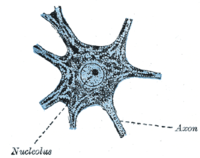
Back G0 fáze Czech Ruhende Zelle German Fase G0 Spanish فاز جی صفر Persian Fase G0 Galician G0 (podfaza) Croatian G0期 Japanese Faza G0 Polish Fase G0 Portuguese G0-фаза Russian


The G0 phase describes a cellular state outside of the replicative cell cycle. Classically[when?], cells were thought to enter G0 primarily due to environmental factors, like nutrient deprivation, that limited the resources necessary for proliferation. Thus it was thought of as a resting phase. G0 is now known to take different forms and occur for multiple reasons. For example, most adult neuronal cells, among the most metabolically active cells in the body, are fully differentiated and reside in a terminal G0 phase. Neurons reside in this state, not because of stochastic or limited nutrient supply, but as a part of their developmental program.
G0 was first suggested as a cell state based on early cell cycle studies. When the first studies defined the four phases of the cell cycle using radioactive labeling techniques, it was discovered that not all cells in a population proliferate at similar rates.[1] A population's "growth fraction" – or the fraction of the population that was growing – was actively proliferating, but other cells existed in a non-proliferative state. Some of these non-proliferating cells could respond to extrinsic stimuli and proliferate by re-entering the cell cycle.[2] Early contrasting views either considered non-proliferating cells to simply be in an extended G1 phase or in a cell cycle phase distinct from G1 – termed G0.[3] Subsequent research pointed to a restriction point (R-point) in G1 where cells can enter G0 before the R-point but are committed to mitosis after the R-point.[4] These early studies provided evidence for the existence of a G0 state to which access is restricted. These cells that do not divide further exit G1 phase to enter an inactive stage called quiescent stage.
- ^ Howard A, Pelc SR (2009). "Synthesis of Desoxyribonucleic Acid in Normal and Irradiated Cells and Its Relation to Chromosome Breakage". International Journal of Radiation Biology and Related Studies in Physics, Chemistry and Medicine. 49 (2): 207–218. doi:10.1080/09553008514552501. ISSN 0020-7616.
- ^ Baserga R (2008). "Biochemistry of the Cell Cycle: A Review". Cell Proliferation. 1 (2): 167–191. doi:10.1111/j.1365-2184.1968.tb00957.x. ISSN 0960-7722. S2CID 86353634.
- ^ Patt HM, Quastler H (July 1963). "Radiation effects on cell renewal and related systems". Physiological Reviews. 43 (3): 357–96. doi:10.1152/physrev.1963.43.3.357. PMID 13941891.
- ^ Pardee AB (April 1974). "A restriction point for control of normal animal cell proliferation". Proceedings of the National Academy of Sciences of the United States of America. 71 (4): 1286–90. Bibcode:1974PNAS...71.1286P. doi:10.1073/pnas.71.4.1286. PMC 388211. PMID 4524638.